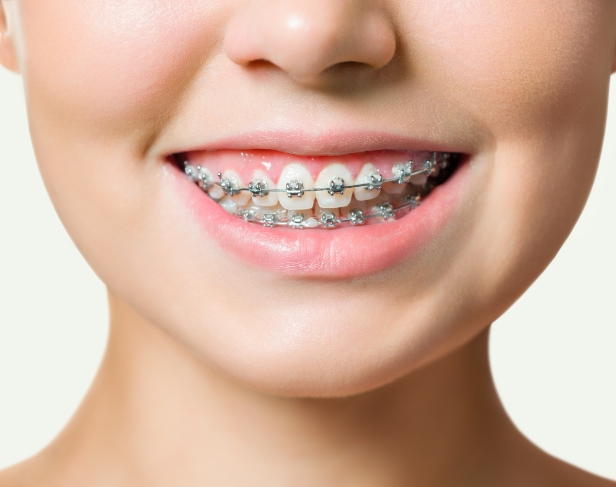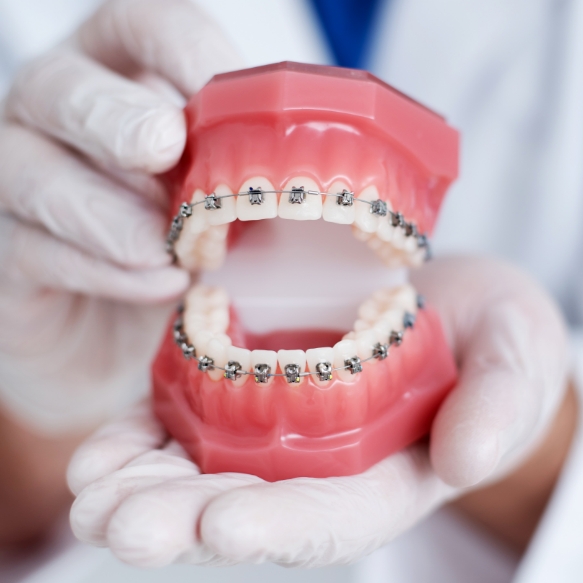Brackets
Braces at IJssel Dental
At IJssel Dental we offer various brace treatments, tailored to your specific needs. Whether you want to protect your teeth during sports, suffer from teeth grinding (bruxism), or want to improve the position of your teeth and bite, we have the right solution for you.
- Protective braces for sports: For athletes, it is crucial to protect the teeth from impact. Our custom-made sports mouthguards offer optimal protection during sports, so you don't have to worry about dental injuries.
- Braces against teeth grinding (bruxism): Teeth grinding, also known as bruxism, can cause serious damage to your teeth and jaw joints. A custom-made grinding guard protects your teeth and reduces the tension on your jaw muscles, preventing pain and damage.
- Braces for dental correction: For people who want to correct their teeth and bite, we offer both traditional fixed braces and Invisalign clear braces. Fixed braces are attached to the teeth and ensure precise shifting of the teeth into the desired position. Invisalign, on the other hand, is nearly invisible and can be easily removed while eating and brushing. Both options provide beautiful, straight teeth and a healthy bite.

Why braces at IJssel Dental?
Personal approach
We perform a thorough evaluation to assess the degree of bruxism and identify any damage to your teeth.
Custom made
For patients with bruxism, we offer custom-made night braces or splints that protect the teeth from the damaging effects of grinding and clenching.
Prevent damage
By taking timely protective measures, we prevent further wear, cracks or fractures to your teeth.
Support
If necessary, we may suggest additional treatments, such as relaxation techniques or physiotherapy, to address the underlying causes of bruxism.

Keeping your own teeth
At our dental practice in Zwolle we do everything we can to keep your own teeth healthy. A protective brace can be an important factor in this. We therefore offer three options to protect your teeth.
Night brace
Custom-made night braces are worn during sleep to protect the teeth from the force of grinding.
Splints
Splints, also known as occlusal splints, provide a protective barrier between the upper and lower teeth to minimize wear and damage.
Monitoring and adjustment
Periodic checks allow us to evaluate the effectiveness of the protection and make adjustments if necessary.
The process of a brace
1. Evaluation & diagnosis
We will discuss your aesthetic goals, dental health and any specific concerns to create a personalized treatment plan.
2. Discussion of treatment options
A combination of treatments, such as crowns, bridges, veneers, Invisalign, implants and other aesthetic procedures, are carefully put together to transform your smile.
3. Customization & fit
We plan the sequence of treatments and carry them out in accordance with your schedule and wishes.
4. Monitoring & adjustment
During the Smile Make-Over we regularly check the progress and make any necessary adjustments.

Frequently Asked Questions About Braces
Why would I need a sports mouthguard?
A sports mouthguard provides essential protection for your teeth during sports. It prevents damage from hard blows and reduces the risk of broken teeth and other dental injuries.
How do I know if I suffer from bruxism?
Bruxism can manifest itself by unconsciously grinding or clenching your teeth, especially at night. Symptoms include sensitive teeth, jaw pain and headaches when waking up. A grinding plate can help reduce these symptoms.
What is the difference between fixed braces and Invisalign?
Fixed braces consist of metal or ceramic brackets that are attached to your teeth, while Invisalign is a clear, removable aligner. Both are effective at straightening teeth, but Invisalign is nearly invisible and can be removed, making it easier to eat and brush your teeth.
How long does brace treatment take on average?
The duration of the treatment varies per person and depends on the complexity of the correction. On average, a brace treatment lasts between 12 and 24 months.
Is it painful to wear braces?
During the first few days after braces are fitted, there may be some sensitivity. This is normal and usually disappears within a few days. We will make sure you feel as comfortable as possible during treatment.
Can I eat normally with braces?
With fixed braces, you have to be careful with certain hard or sticky foods to avoid damaging the braces. With Invisalign, you can remove the aligners while eating, so you don't have to restrict your diet.
How often do I need to come back for check-ups during orthodontic treatment?
Regular check-ups are essential to monitor the progress of your treatment and make adjustments if necessary. These check-ups usually take place every 4 to 8 weeks.
Why would I need a sports mouthguard?
A sports mouthguard provides essential protection for your teeth during sports. It prevents damage from hard blows and reduces the risk of broken teeth and other dental injuries.
How do I know if I suffer from bruxism?
Bruxism can manifest itself by unconsciously grinding or clenching your teeth, especially at night. Symptoms include sensitive teeth, jaw pain and headaches when waking up. A grinding plate can help reduce these symptoms.
What is the difference between fixed braces and Invisalign?
Fixed braces consist of metal or ceramic brackets that are attached to your teeth, while Invisalign is a clear, removable aligner. Both are effective at straightening teeth, but Invisalign is nearly invisible and can be removed, making it easier to eat and brush your teeth.
How long does brace treatment take on average?
The duration of the treatment varies per person and depends on the complexity of the correction. On average, a brace treatment lasts between 12 and 24 months.
Is it painful to wear braces?
During the first few days after braces are fitted, there may be some sensitivity. This is normal and usually disappears within a few days. We will make sure you feel as comfortable as possible during treatment.
Can I eat normally with braces?
With fixed braces, you have to be careful with certain hard or sticky foods to avoid damaging the braces. With Invisalign, you can remove the aligners while eating, so you don't have to restrict your diet.
How often do I need to come back for check-ups during orthodontic treatment?
Regular check-ups are essential to monitor the progress of your treatment and make adjustments if necessary. These check-ups usually take place every 4 to 8 weeks.

